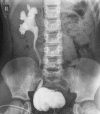Urinary tract infections in children: an overview of diagnosis and management
- PMID: 31646191
- PMCID: PMC6782125
- DOI: 10.1136/bmjpo-2019-000487
Urinary tract infections in children: an overview of diagnosis and management
Abstract
Urinary tract infections (UTIs) are a common and potentially serious bacterial infection of childhood. History and examination findings can be non-specific, so a urine sample is required to diagnose UTI. Sample collection in young precontinent children can be challenging. Bedside dipstick tests are useful for screening, but urine culture is required for diagnostic confirmation. Antibiotic therapy must be guided by local guidelines due to increasing antibiotic resistance. Duration of therapy and indications for imaging remain controversial topics and guidelines lack consensus. This article presents an overview of paediatric UTI diagnosis and management, with highlights of recent advances and evidence updates.
Keywords: general paediatrics; nephrology.
© Author(s) (or their employer(s)) 2019. Re-use permitted under CC BY-NC. No commercial re-use. See rights and permissions. Published by BMJ.
Conflict of interest statement
Competing interests: None declared.
Figures



References
-
- NICE Resource impact report: Urinary tract infection in under 16s: diagnosis and management (CG54): National Institute for Health and Care Excellence; 2017.
Publication types
LinkOut - more resources
Full Text Sources
